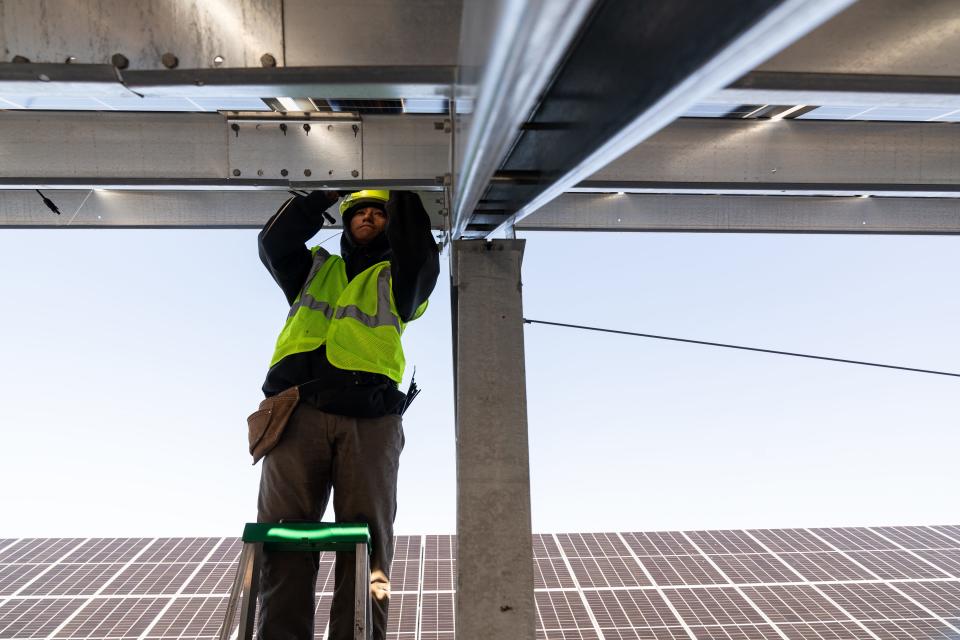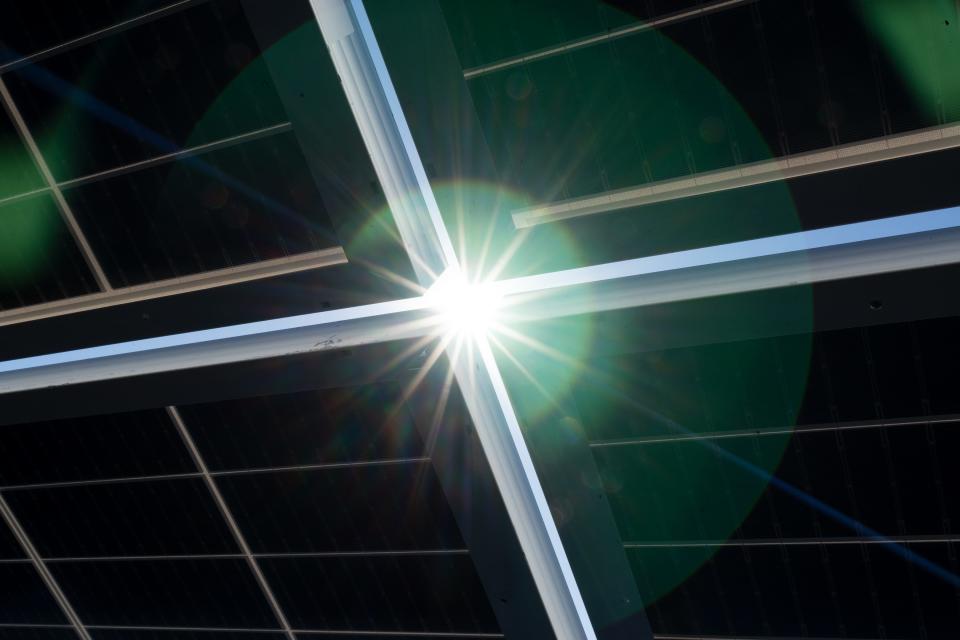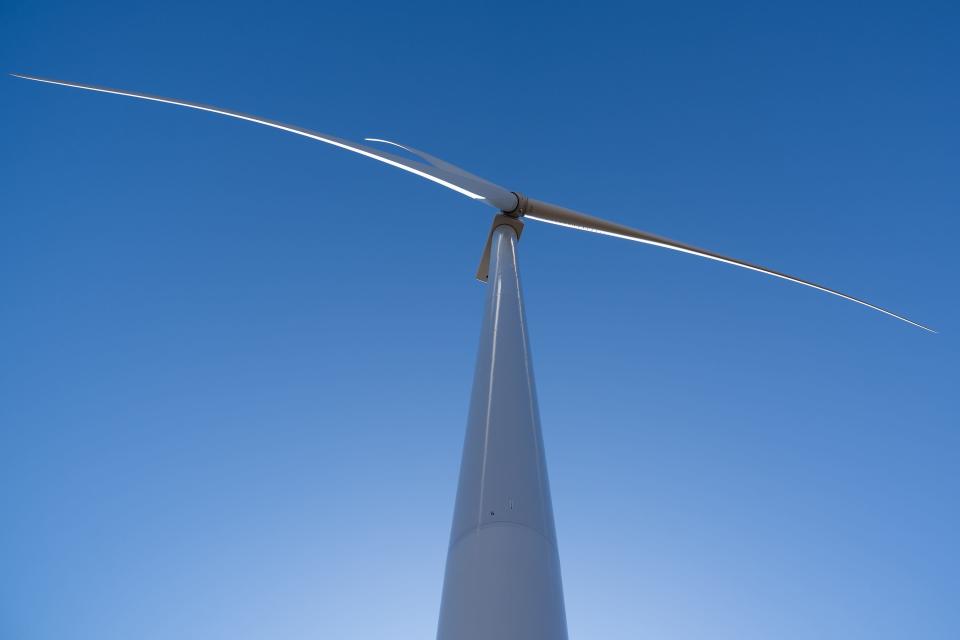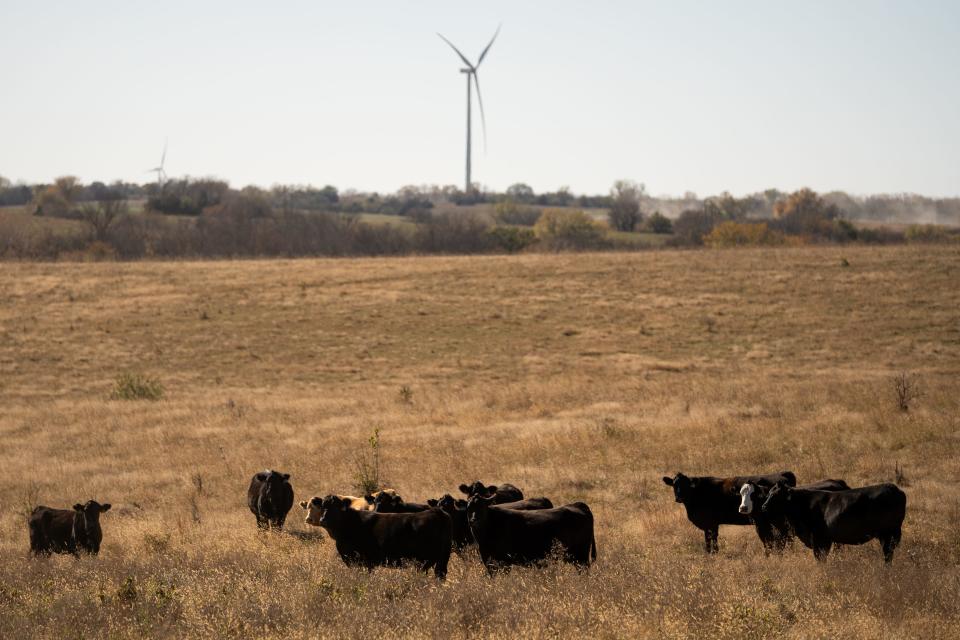Do wind turbines kill birds? Are solar panels toxic? The truth behind green-energy debates

The United States and the world are in a race against time to shift from greenhouse gas producing energy sources to carbon-free ones, which at this point means either nuclear plants, hydroelectric power, or solar and wind farms.
Wind turbines and solar panels – which must be the main way forward – have been subject to mis- and disinformation campaigns. Alan Anderson heads the energy practice with the law firm of Polsinelli and says when he hears arguments against wind and solar, he thinks of bears and Bigfoot.
“Bears are real – if you have a bear in your campsite, that’s not good,” the Kansas City, Missouri-based attorney said. “But if someone says there’s a Bigfoot in their campsite, it’s not real.
“We're burdened by having to give factual information that's backed by science and engineering, whereas the other side's not. So we're at a disadvantage,” he said.
That contrast was on display recently at a commissioners meeting in Madison County, outside Columbus, Ohio. The proposed Oak Run solar farm would produce 800 megawatts of clean electricity, bringing an estimated $250 million in tax revenue over the project’s 35-year life and providing dozens of long-term jobs.
It would also cover at least 4,000 acres with solar panels and require four to eight years to construct.
A crowd of neighbors was there to make sure that didn’t happen.

The panels would “take up prime farmland” and kill birds, they said. “These are eyesores,” said Heather Crum, of Somerford township. She and her husband moved to the area almost 20 years ago. “Had we known, we would have done a 360.”
Locals are waiting for the Ohio Power Siting Board to decide whether the solar farm can be built. However, they’ve already taken steps to make sure no other such projects can ever come to their county. On Sept. 12, the county commission voted to prohibit all new wind and solar farms.
Across America, scenes like this one play out when large green energy projects are proposed. Some of the common objections are a matter of opinion – are wind turbines ugly or beautiful? Does a field of solar panels ruin a rural setting, or help preserve it?
But other arguments are based on false information. Here’s a breakdown of the most common ones.
The issue: Do wind turbines kill birds and bats?
The short answer: Yes, wind turbines can kill both bats and birds. But the more important question is how many they kill compared with other sources.
Buildings are estimated to kill up to 988 million birds a year and outdoor cats are an enormous danger to birds. By one estimate, free-ranging domestic cats kill between 1.3 billion and 4 billion birds each year.
A study to be published in 2024 found that wind farms had no statistically significant effect on bird counts. But another kind of energy did. Fracking reduced the total number of birds counted in near shale and oil production sites by 15%.
And all of that is separate from considering the impact of climate change.
The National Audubon Society has estimated that as many as two-thirds of North American bird species – 398 species – are at risk of extinction due to changes in habitat caused by global warming.
The issue: Are solar farms dangerous for birds?
The answer: Some water birds can mistake a large solar farm for a body of water and attempt to land on it, which can harm the birds. However, according to the National Audubon Society, some developers are adding special patterns to panels or using other strategies to minimize the risk of crash landings. Audubon also notes that many states require solar developers to grow native plants in and among solar farms, benefiting birds and other pollinators.
The issue: Power produced by wind and solar is just exported to people in other areas. Why should we have to produce it here?
The answer: Agricultural communities have always exported what they produce, whether it’s crops or livestock. “The beef and potatoes that ranchers and dairymen produce in Idaho don’t all stay in Idaho,” said John Robison, public lands director for the Idaho Conservation League.
People in those communities see wheat and corn and soy being grown, see combines and grain bins, and know there’s money for farmers and taxes for their communities. Solar advocates and energy developers say their task is to persuade people living near turbines or solar farms to look at them and realize it means jobs and better-funded schools and repaired roads.
The issue: Will worn-out solar panels overwhelm dumps with waste?
The answer: Improved standards for solar panels and wind turbines mean both have much longer lifespans today than they did a decade ago. Panels typically last 30 to 35 years while turbines have a lifespan of about 30 years.
At that point, it’s true: They must be decommissioned and disposed of. But the trash this will eventually produce pales in comparison to that produced by households, coal ash and plastic waste.
Globally, municipal waste is expected to reach 70 billion metric tons by 2050, coal ash (the byproduct of burning coal) more than 45 billion metric tons and plastic waste 12 billion metric tons, a study published in the journal Nature Physics in October 2023 found.
In comparison, even in the worst-case scenario, waste from solar panels is expected to reach 160 million metric tons globally by 2050.
Most solar zoning codes require that the companies post bonds for decommissioning them at the end of their lifespans so that counties don’t have to deal with disposal.
The issue: Do solar panels contain toxic materials such as arsenic, cadmium and gallium? Will that leach out of them in the rain?

The answer: There are a couple different issues here, including questions of what’s really in the panels and also whether any of that stuff is actually risky. Here’s the breakdown.
Solar panels are mostly made of glass, aluminum and silicon – 77%, 10% and 3%, respectively. It’s true that trace elements are added to make them better conductors of electricity, usually cadmium and copper.
What’s less true is the idea of some other poisonous substances. Despite the fact that some states have gone so far as to ban use of these materials, there’s no evidence that today’s photovoltaic cells contain arsenic, germanium, hexavalent chromium or perfluoroalkyl substances. All of these items could, indeed, be poisonous, but they simply aren’t there.
The other question is whether it’s possible for any of those materials to exit the solar panel and poison something else.
Research published in the Journal of Hazardous Materials in 2017 found that it’s possible to release the trace amounts of cadmium in a solar panel – but to do so, you’d first have to crush up the panel and then put the resulting powder in an acidic environment over several weeks.
The bottom line: There’s just not evidence of toxic material leaching out of solar panels in the rain.
That hasn’t stopped this argument from taking root. In Horry County, South Carolina, in 2020, in response to a proposed 138 megawatt solar project, community members raised concerns about the leaching of cadmium telluride, questioning what would happen if the solar panels were damaged in a hurricane. County council members also raised concerns about decommissioning and whether landfills would accept solar panels. Although the developer agreed not to use solar panels that include cadmium telluride, the project was never built.
The issue: Will wind turbines hurt nearby property values?

The answer: A study by Lawrence Berkeley National Laboratory published in December found that, on average, homes located within one mile of a commercial wind turbine experience about an 11% decline in value following the announcement of a new commercial wind energy project. Homes between a mile and two miles were slightly affected, and any house more than two miles away wasn’t affected at all.
However, the effect was short-lived. Prices returned to pre-announcement levels within three to five years after the power project opened.
The study looked at nearly 500,000 home sales across 34 states near 428 different wind projects between 2005 and 2009. To be clear, during that time, wind turbines were not as tall as state-of-the-art turbines today. However, because modern turbines are taller and produce more energy per turbine, fewer of them are required, so the area of potential shadow and noise is smaller.
Research in the journal Energy Policy in 2022 showed that home values increased after wind projects began operating, though that is probably because taxes from the projects provided economic benefits to the area including better schools and infrastructure, making the community more enticing.
The issue: Do wind turbines create harmful, low-frequency noises?

The answer: Sound from wind turbines may be annoying, but it has no established adverse health effects, according to Peter Thorne, a professor and head of the University of Iowa's Department of Occupational and Environmental Health.
Some opponents have said that turbines emit a low-frequency “infra-sound” that causes headaches, nausea and other problems. But a report published in 2019 found no link between health outcomes and proximity to turbines.
While researchers said the symptoms were often real, they were linked to beliefs and negative expectations, not the turbines.
The issue: Will solar farms use up all our farmland?
Farmland is a popular place to build solar because it’s generally relatively flat and open. Not surprisingly, places where people grow crops tend to have good sunlight.
So an increasingly common argument for curtailing solar projects is to preserve farmland. Some counties now set limits on the amount of agricultural land that can be turned into a solar farm.
Opponents argue that too much farmland being turned into solar farms will affect the country’s ability to feed itself.
The answer: No, solar will not use up all the farmland we need.
The National Renewable Energy Laboratory estimates that for the U.S. to move completely to carbon-neutral power, it will require about 10,000 square miles of land.
The Department of Agriculture already pays farmers to take about 24.8 million acres of less productive and environmentally sensitive land out of production. That’s 38,750 square miles – more than the entire amount of land that would be needed for green energy.
And in 2023, about 40% of the U.S. corn crop was used to produce ethanol. By some measures, an acre of solar power can make 70 times as much energy as an acre’s worth of corn turned into ethanol.
The issue: Can’t we put solar on top of old warehouses so we don’t need big fields of solar panels?
One version of this argument asserts that by placing solar panels on old industrial properties that have limited uses – such as old surface coal mines, chemical plants or former military sites – no undisturbed land will need to be used for solar power.
This is called turning “brownfields” into “brightfields,” and avoiding solar on “greenfields.”
There are two problems. One is that there can be a high added expense to building on potentially toxic ground.
Such projects can and often are placed on old landfill properties, but these are still more expensive than farmland or scrubland.
The answer: Either way, solar panels ultimately have to cover acreage because they all need to face the sky. There simply aren’t enough brownfields to reach the full needs of the energy transition.
The issue: Do wind and solar farms destroy rural aesthetics?

There’s no rebuttal to this one: Beauty is in the eye of the beholder. Some people behold a wind turbine or a solar installation and see clean energy that will help stop global warming and make the United States more energy independent. Others see them as a blight that destroys the landscape and turns it into an industrial eyesore.
“They’re ugly, they don’t work and they can explode,” was how Elizabeth Finke described them at a hearing on a proposed solar installation near her family farm in Madison County, Ohio.
It’s worth noting that solar farms, compared with wind turbines, sit relatively low to the ground. In some parts of the country, once those panels are screened off by a row of trees or vegetation, they’re hardly visible from afar. Still, they draw ire.
This story was produced with support from the McGraw Center for Business Journalism at the Craig Newmark Graduate School of Journalism at the City University of New York.
This article originally appeared on USA TODAY: Green energy, fact-checked: Are wind turbines bad, solar panels toxic?
Solve the daily Crossword

